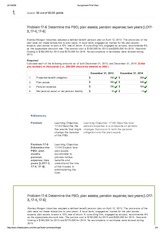
Cash accounting, however, can result in distortions through end of year tax strategies.So, agricultural accounting requires both cash for tax filing and accrual for accurate financial statements. Most traditional accounting programs require that users select one or the other or maintain two sets of books, which just isn’t realistic. With well-designed farm accounting software, there’s no need to choose.

While creativity and ingenuity on the farm are definitely assets, there’s plenty to be said for having the right tools for the right job, especially when it comes to efficiency. Leverage the internship experience by securing a full-time position as a corporate accountant upon graduation. Or continue your education for a one-year certified Masters of Accountancy Science program to earn the additional 24+ hours required to become a certified public accountant (CPA) and meet the minimum 150 hour requirement. Complete a summer internship with a Fortune 500 company like John Deere, Caterpillar, Archer Daniels Midland or a public accounting firm like Deloitte or Price Waterhouse Coopers or Crowe Horwath.
Agriculture is rife with activity that qualifies for the R&D tax credit.
A single-entry accounting system is characterized by only one entry made for each transaction, much like a check register. However, a single-entry system does not tract accounts like inventory, accounts payable/receivable, nor create a balance sheet or income statement. In cropping operations, that surrogate is the “(Cash) Investment in Growing Crops” line found on most agricultural balance sheets. It’s an easy value to determine–just total up the cost of the crop inputs “in the ground” at the time of the statement.
These penalties can add up, too — up to a hefty 15% of the initial amount owed. Despite all these methods and KPIs, there is only one tried-and-true method to accurately gauge your farm’s profitability — accounting professionals. Accounting professionals, such as the pros at FinancePal, have a wealth of experience and a knack for analyzing numbers in creative ways to determine the true performance of a business. Another useful KPI is revenue per unit of area — a measure of how much revenue or profit is generated for each unit area of farmland, such as dollars per hectare. While this gives a good idea of current farm performance, it can gloss over underlying costs; as farmland with recent development will perform better under this KPI but may not bring in as much profit as less fecund farmland that requires less maintenance.
Rabobank Conducts Agricultural Finance Workshops in NSW – Mirage News
Rabobank Conducts Agricultural Finance Workshops in NSW.
Posted: Sun, 20 Aug 2023 23:26:00 GMT [source]
One of the most important variables is the use of cash and the need for cash accounting. My last Cornhusker Economics article, Accounting Assumptions and the Farm Business set the foundation for a specific evaluation of the conceptual framework accrual accounting offers the farm or ranch manager. The article addressed cash accounting and hinted at its shortfalls which were rectified by accrual accounting. This article will explain conceptual frameworks, and two accrual accounting principles; namely the revenue recognition principle and the matching principle.
We comment on seven IFRS Interpretations Committee tentative agenda decisions
Finding ways to improve the profitability of your farm is crucial for your long-term success. MacGyver might have had the television show, but when it comes to working with what’s at hand to get a job done, few people are better at this than farmers and ranchers. We’ve become accustomed to improvising and making what we have work when the right tools or resources aren’t always available.
The findings of this study reveal the importance of supportive institutions, human capabilities and international collaboration in aiding research and development. It provides an overview of agricultural accounting literature over the years and aid researchers in this research domain to explore more studies and develop better arguments. The most frequent keywords connecting to author’s area of research, as highlighted in Figure 5, include agriculture, accounting, water accounting, environmental accounting and cost analysis. Work-in-process inventories are all partly completed units found in production at any given point in time, e.g. cars on an assembly line.
Farming + Agriculture Accounting
You must keep all records that show your farming business’s income and expenses. This includes supporting documents for purchases, sales, payroll, and all other business transactions. This scenario comes up often this time of year when producers are sitting on large revenue (and profit) projections for the year. Their cash income tax returns show large gains, and many want to mitigate income tax liability. One easy solution to this problem is to buy inputs for next year’s crop.
Conditional grants are recognised as income only when the conditions attaching to the grant are met. The first is the Economic Farm Surplus, which is a favorite of accountants. The Economic Farm Surplus can help farmers gauge performance based on inventory and asset metrics. Some examples include a cultural shift towards vegetarianism, which can lead to pasture being converted to non-animal production.
In agricultural accounting, valuation is also determined by market value. Agricultural accounting is just different from standard accounting and having the right tools to assist your farm managers and agricultural accountants in keeping records straight is vital. This paper presents empirical research comparing the accounting difficulties that arise from the use of two valuation methods for biological assets, fair value (FV) and historical cost (HC) accounting, in the agricultural sector. It also compares how reliable each valuation method is in the decision-making process of agents within the sector. By conducting an experiment with students, farmers, and accountants operating in the agricultural sector, we find that they have more difficulties, make larger miscalculations and make poorer judgements with HC accounting than with FV accounting. In-depth interviews uncover flawed accounting practices in the agricultural sector in Spain in order to meet HC accounting requirements.
Farm Accounting
I tell students this entry is like buying the product from yourself. Under some circumstances — such as if revenue exceeds $5 million on the PnL statement — agriculture businesses may be required to utilize either the accrual method of accounting or a hybrid of accrual and cash method. In the case of accounts receivable/payable, cash accounting has no way to record the event. Accrual accounting does not have this issue when it comes to pre-buying inputs. Let us see how the conceptual framework of accrual accounting handles the following scenario.
Given those rules and a larger understanding of what WIP means for agricultural accounting, work-in-process should be reported at cost as it accounts for the resources used, but not the finished product. Finished goods may be reported at the lower of cost or market (with market price calculated as current sales price less estimated cost of disposal). The major challenge is that whether you choose to report inventories at cost or lower of cost or market, you must be able to determine your work-in-process costs. That’s why we emphasize management accounting as the first step in moving our clients to financial reporting.
- Let us see how the conceptual framework of accrual accounting handles the following scenario.
- It is the best option and is the accepted accounting system in use for most businesses today.
- Having up-to-date records also helps you better plan for, take advantage of, and record government subsidies for farmers.
- However, IAS 41 applies to the produce growing on those bearer plants.
- For that reason, accountants can typically move fluidly between businesses and books with little variation.
Combining all aspects takes detailed record keeping, a good understanding of the ins and outs, and the right tools. Accounting software designed for retail or manufacturing assume short, evenly-distributed turnover. On the other hand, crop and livestock production and marketing are characterized by long overlapping cycles that rarely correspond to calendar years. Software designed specifically for farm management simplifies this process and considers these factors in standard functionality. Traditional practices of financial record keeping have largely been informal, simple, and vary from the generally accepted accounting principles (GAAP), which have long been used in other businesses.
Additional costs of growing crops, such as soil preparation, fertilizer, or pesticides are also allocated to the harvested crop. The cost of maintaining your land should always be accounted for. Keep track of all money spent on Agricultural accounting fertilizer, irrigation, drainage, soil pH management, weed removal, and pest control. Nondeductible farm expenses include personal, living, and family expenses, such as the cost of maintaining your personal vehicles or horses.
Management accounting in modern times is a universal integrated mechanism for the accounting and management activities of an agricultural organization. The management accounting information system should be oriented towards solving complex issues and making managerial decisions quickly. The purpose of the study is the rationale for rationing, planning and management accounting of costs, their control and analysis of production results in the agricultural management information system. The subject of the study is management accounting, while principles are formulated and new methods for rationing labor, material and biological costs of agricultural production are proposed. There are a few substantial differences between agricultural accounting and business accounting, however.
Family operations (and their lenders) are even less informed, usually basing livestock inventories on purely arbitrary “market” values. WIP calculations for livestock are much more complex than those for crops. For livestock, there are daily, rather than seasonal, activities and the challenges of capitalizing development costs for replacement breeding animals and gestating and lactating “pre-weaned” animals. Production animals with short lives are usually considered inventory; the shorter lifespan (operating cycle) lends well to the inventory designation. All other livestock, such as breeding animals, cattle, sheep, goats, and longer-lived production animals are usually considered assets. Both the direct and indirect costs of care and development are tracked and accumulated until maturity.
AccountingTools
Unlike true WIP, though, “Investment in Growing Crops” fails to account for the labor and indirect costs (such as fuel, repairs, depreciation and rent) also invested in that growing crop. As a result, assets are often understated and expenses overstated in the accounting period. Agricultural accounting, or AG accounting, is the process of accounting for your farm, ranch, or related business. Keeping accurate and up-to-date records helps you to prepare for tax time, create financial statements, make informed decisions, and measure your farm’s financial health. Like any business, you need up-to-date accounting records if you run a farm, ranch, or related operation. But, some aspects of agricultural accounting—like livestock and land—are specific to farming businesses.
Simply put, agricultural accounting covers the specialized accounting required to manage a farm or ranch. While there are a lot of similarities between the agricultural industry and other businesses, agricultural accounting requires a keen understanding of the farming business and the different ways transactions occur. In most businesses, both bookkeeping and transactions are standardized to create consistency. For that reason, accountants can typically move fluidly between businesses and books with little variation. However, in farming, there are a lot of variables that come in due to the nature of the business and the way transactions are handled.
However, if a farmer values livestock inventory using the farm-price method, then they must obtain IRS permission to change to the unit-livestock-price method. The cash method of accounting is the most common method among farm and agricultural businesses as it is simpler and more straightforward than the accrual method. Farm enterprise analysis, or the practice of analyzing your cost centers, profit centers, and assets in your various farming operations to identify… Students in this concentration discover how to apply accounting principles in financial, production, processing, or retailing sectors of the agriculture and food industry.